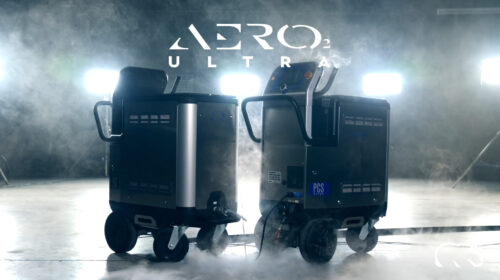THE SITUATION
New Age Cryo started under Stoc Products, an automated valve and controls company serving industrial and chemical plants and ethanol manufacturing facilities. Roughly two years ago, the company was asked by one of its ethanol manufacturing customers about plant maintenance and how it might recommend that the plant be cleaned during its semiannual scheduled maintenance shut-downs. For New Age Cryo, the answer was dry ice blasting.
THE PROBLEM
In the U.S. ethanol industry, there are roughly 190 plants, and New Age Cryo provides dry ice blast cleaning services to 40 of them. Prior to the introduction of dry ice blasting to the industry, many of New Age Cryo’s customers faced significant challenges with maintenance.
The two major catalysts for plant maintenance are saving natural gas, one of the operators’ biggest expenses; and removing the byproduct of the manufacturing process, distillers dried grains (DDGs), or corn dust, which inevitably coats everything in the plant, from the walls to the grain pits. One of the most important areas that need to be maintained is the energy center of the ethanol plant. This includes cleaning of the thermal oxidizers, stack coils, ID Fans, damper boxes, dryer drops and duct work. By cleaning these items, particularly the refractory in the HRSG and stack coils, the equipment will operate with much greater efficiency resulting in average stack temperature drop of 40-60 degrees.
When the refractory collects on the stack economizers, for example, the equipment cannot operate effectively, greatly reducing their thermal efficiency and ability to generate steam. The refractory coats the economizers and forces the plant to use more natural gas. The process side of the plant is another area that needs to be maintained. New Age Cryo is working with dry ice cleaning systems manufacturer, Cold Jet, to develop technology to clean the beer columns, rectifiers and other critical pieces of equipment in the process area.
According to OSHA guidance, ethanol producers cannot have more than a 16th of an inch of corn dust on any standing structures. This includes Pits, Tunnels, DDG Building, and off load buildings to name a few. Dry ice is a clean, EPA recognized way to remove this dust with minimal hazards. For many ethanol producers, the only method known to clean their plants and remove the DDGs is water blasting. When it comes time for a plant’s semiannual cleaning, water blasters either tap into a water supply on the plant or bring in their own water. As they clean the plant, the water is either left standing, removed by trucks, or pumped back into the plant system. All of this creates a large extra expense. The cleaning process typically takes 36-48 hours and requires a 15-18 person team to clean the equipment and the secondary waste consisting of water, dirt, grease and corn dust. By using dry ice the secondary waste is minimal.
Shawn Easterly, an ethanol energy center expert and head consultant for New Age Cryo, has managed several ethanol plants, including coordinating maintenance for four facilities in the Midwest. He had previously managed 16 ethanol plants for another ethanol producer.
Brad Potts, owner of New Age Cryo, added, “Water simply causes too many potential problems, and many of our customers have decided to go with waterless energy centers. Instead of removing hundreds of gallons of water, treating the water, or waiting weeks to run it through plant systems, dry ice has become a popular alternative. Water does not mix with the grease or the machines, equipment with electronics has to be covered or avoided, and despite efforts to remove the water, it can be weeks before it is completely gone.” Easterly added, “Even in the plants that I began overseeing, they had avoided cleaning the economizers either because they feared damaging the refractory or simply because they didn’t understand the impact that the blocked economizer tubes had on their bottom line. Once I started to calculate the lost efficiency due to the clogged stacks, however, we realized that we needed to find an alternative to water.”
THE SOLUTION
Dry ice blast cleaning provides all the benefits of high pressure water without the negative impacts. Dry ice blasting uses reclaimed CO2 in the form of dry ice pellets to remove the layers of DDGs from various parts and equipment within an ethanol plant. Blasted using controlled pressurized air, the dry ice pellets sublimate upon contact with equipment without damaging the surface being cleaned and without producing any secondary waste.
Armed with the Cold Jet Aero series dry ice blast cleaning systems, New Age Cryo is able to clean the economizer and boiler tubes, ID fans, grain tunnels, DDG tunnels and pits, gas stations, lime slurry stations, wet cake areas and the off load buildings. In addition, since dry ice blasting is a dry cleaning process, New Age Cryo can also clean electronics components without worrying about damaging the equipment.
“The process works extremely well in ethanol plants,” stated Easterly. “We are able to clean these areas in the plants with fewer people and without the mess left behind by high pressure water blasting. It is safe to say that dry ice blasting will likely become the standard cleaning practice in these areas of the ethanol plants.”
THE RESULTS
As a result of being able to more effectively clean the equipment and areas of the plant, ethanol producers are finding significant costs and energy savings by adopting dry ice blasting. According to Easterly, it was not uncommon for his plants to see a 40-60 degree drop in stack temperatures after each cleaning. This results in increased production, significant savings in natural gas, and less emissions.
“By cleaning our stack economizers every six months, we saved $100,000 per plant in natural gas savings alone,” said Easterly. “With four plants, the annual savings totaled roughly $400,000 for the company. The economizer coils pre-heat the water for the ethanol production process, but when the coils are covered by the refractory, they are less efficient at heating the water and producing steam, so we have to use more natural gas. Dry ice blasting has allowed us to reduce the amount of gas that we use, while also helping us to run at higher rates.”
Potts emphasized that these savings and benefits are not unique.
He concluded, “A reliable, durable cleaning system that cleans faster, with zero secondary waste and less mess is clearly something that can help the industry. Ethanol plants across the country are identical in design and also struggle with the same cleaning challenges. That said, many ethanol plants can also realize similar savings and benefits as described above by implementing dry ice blast cleaning into their maintenance process.”


